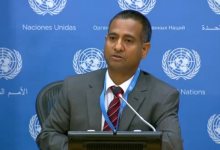Aadel Collection
Iran’s women of war
8/10/2010
Iran's Women of War I The New York
NYRbiog: Roving thoughts and provocations from our writers
Roving thoughts and pro vocations from our writers
Iran's Women of War
Ha leh Esfandiari
ZahraRahnavsrdwavingto supporters during a campaign
rally for her husband, Mir Hussein Moussavi, at
Haydarniya Stadium, Tehrsn, June 9, 2009 (Atta
KenareIAFP/Getty Images)
It is entirely appropriate that two women have become the ieonie symbols of Iran's protest movement.
Thanks to cell phones and the Internet, millions of people around the world saw footage of the blood-
soaked face of the young Neda Agha Soltan, as she lay dying on a Tehran street, shot by security forces
during a peaceful demonstration. But even before last June's rigged presidential election, Zalira Rahnavard,
the wife of opposition candidate Mir Hussein Moussavi, had gained international renown as the first woman
in Iranian history to campaign alongside her husband—making speeches of her own and taking a strong
stand on controversial social issues.
Ms. Ralmavard has caused a stir, but also set an example . An author and educator in her own right, she was
the first female chancellor of any Iranian university—she directed Alzahra University in Tehran from 1998
until 2006—and has served as a political advisor to former president Mohammed Khatami. During the
campaign, she was outspoken in calling for reform and also courageously endorsed the demands of the One
Million Signatures campaign, a women's rights movement whose leaders have been attacked and arrested by
the Iranian authorities.
Following her example, the wives of the other candidates began to appear on the campaign trail as well.
Women were active in the campaigns of the two leading opposition presidential candidates; and when
hundreds of thousands of protesters poured into the streets after Ahmadinejad was, improbably, declared
the winner, women marched alongside the men, braving assaults and intimidation from the riot police,
paramilitary forces, and knife-, club- and chain-wielding goons the government sent after the demonstrators.
As an activist friend wryly told me, “They treated us equally. They beat, clubbed and arrested us just like the
men.” (In a sign of the growing weight of the women's vote, President Ahmadenjjad—his legitimacy in
serious doubt—sought to mollify this constituency by nominating three women to his cabinet, though
parliament confirmed only one of them.)
Women have in fact been at the forefront of resistance to an intrusive state ever since the establishment of
the Islamic Republic. In the early years of the revolution, they resisted the new regime's attempt to force
them out of the workplace and universities. They found subtle ways—such as showing a bit of hair and
wearing shorter robes in pastel colors—of challenging the restrictive dress code the government imposed on
them in the name of Is lam. They refused to stay segregated, whether in the university classroom or m taxis.
Today, more women than men win admission to universities in competitive state-wide examinations, and this
trend has so alarmed some members of parliament in recent years that there has been talk of legislation to
impose quotas: affirmative action in the mterest of men!
In the mid-1990s, women flocked to support the reform-minded administration of President Mohammad
Khatami, accounting for, in part, the large majorities by which he won his two terms in office. With the One
Million Signatures campaign, launched in 2006 and aimed at collecting a million signatures for a petition
protesting discriminatory legislation against women, the women's movement entered a new phase, implicitly
calling for a revision of laws rooted in the basic principles of Islam. Arrest, trial, heavy fines, and
imprisonment have not deterred the leaders of this campaign, who come mostly from the broad middle class
nybooks.com/. ./irans-women-of-war/
1/3
8/10/2010 Iran's Women of War I The New York
an 2 1 have gone to small towns and villages as well as th lage cities to collect s'ignatures.
The participation by women in the latest series of protests marks another notable development. Women have
shown themselves ready to do what had generally been regarded as ‘men's work.” Despite the risk of
beatings, injury, arrest, even death, they have continued to take a leading part in protests and
demonstrations. The demonstrators' chant, “we are men of war,” has changed to “we are men and women
of war.”
When T was held in solitary confmement in Tehran's Evin Prison in 2007, I was questioned at length about
the women's tights movement; my two interrogators seemed alarmed and befuddled by it. They certainly
feared its potential: how else to explain the harsh way in which officials have dealt with the women collecting
signatures for a simple petition? But my interrogators also told me they feared a backlash if they used
excessive force to disperse female demonstrators.
That was three years ago. Now, the gloves are off The sight of tens of thousands of women marching
alongside men in demonstrations last June seems to have unnerved the authorities. Under the increasingly
brutal regime of Ahmadinejad ‘s second term, Iranians have seen young and middle-aged women clubbed,
dragged across pavements, and hustled into vans by police and official thugs in plain clothes. Rahnavard
has steadfastly condemned the brutality of the security forces.
Only last week, mothers of young men and women who have disappeared in prisons or other government
black holes, and who have been gathering every Saturday in a Tehran park to demand news of their loved
ones, were beaten and arrested by security men. They have since been released but some may be asked to
appear in court. Such scenes are now seared into the memories of Iranians; they will come back to haunt the
regime for years to come.
January 14, 2010 4:45p.m.
— Previous Next —*
Comments for this psge are closed.
Showing 7 comments
Sort by Newest first v I ] Subscribe by emsil Subscribe by RSS
All 02!04/2OlOOl:12AM
As long as then fundamentals of Islamic Republic Constitution are sccepted as is, it is irrelevant who is the president.The supreme leader can null anything that is a
threat to the power of conservative establishment.
2 people liked this.
dswkimble 01/16/2010 12:56AM
Mis Hussein Mousavi was Prime Minister in 1985-6 when he was the Iranian end of the Iran-Contra Scandal (which was whitewashed in Washington by Lee hamilton,
Esfandiari's boss at the Wilson Center). Mousavi thought it was OK to buy weapons from US-Israel while calling them the the Great and Little Satan. Just the sort of
person you can trust.
Mousavi was Prime Minister when he met with AQ Khan in 1987 and bought enrichment technolng' from him. The very enrichment technolo r the US is now falling
over itself to try and stop.
And Mousavi was Prime Minister in 1988 when the bigeest slaughter of prisoners occurred in the bloody history of Iran. 3,000 (some say 6,000) were killed.
And now Eafandiari thinks Mousavi would be a really good person to have instead of Ahmadinejad because he respects human rights. This is just what you would
expect from the organisation that uses the “National Endowment for Democracy” to hind the overthrow of democratic institutions around the world. Total hypocrites,
in other words.
2 people liked this.
Retired 01/16/2010 04:06 PM
I have reread this article by Dr. Esfandiari and can't seem to find any advocacy on behalf of Mousavi OR his wife, much less any respect for human rights on the
part of Ahmadinejad. Instead, I read an analy sis of the actions of Iranian women acting in their own interests that often seem confusing and contradictory to
Westerners and how their determination has at times befuddled and outmseuvered the regime in power. it is crucially important to understand the dynamics at
work ins complex country ruled by a cruel and potentially dangerous government. That purpose can't be achieved by mere polemics.
Tehrani 01/15/2010 11:07 AIvI
I am afraid to say the arrested mothers used to gather in the beginning of the protests in Laleh Park to demand some news of their loved ones - whereas now this event
has transformed to the gathering of those whose dear ones are killed and every week on Sundays just go to the same place and sit there silently grieving and
nybooks.com/. ./irans-women-of-war/ 2/3
8/10/2010 Iran's Women of War I The New York
commemorating for their losses.
(Edited by a moderator)
2 people liked lhis.
elabdul 01/1512010 09:37 AM
Drparvizkoupai, the fundamental legaliatic tenanta of lalam and women'a righta are not mutually excluaive commitmenta. Juat becauae ahe wrapa heraelf ‘heavily like a
bear', doean't mean she ia not a courageous and effective advocate for the women of her country. “Women'a rights” don't mean an automatic forfeit of deeply held beliefs
and attitudes about Islam or its recommendations, they mean that a women has the right to choose how she wants to behave. For you to ridicule her for choosingto
maintain a traditional profile is similar to what extremists Muslims do, simply from the converse perspective; you advocate the talcing of womens' rights to dress and
preserve their modesty in whatever way they please, in the same way that extremist Muslims advocate the taking of womens' rights to dress and show their bodies in
whatever way they please.
3 people liked this.
persia8 01/16/2010 04:51 AM _____________
it is obvious that you know nothing about the fundamental tenants of Islam regarding women. According to Islam women are second half citizen. They would
inherit half as much as men, their testimonies in court is worth half as much as men, men can marry four women Her only objective in participating in her
husbands campaign was an fatuous attempt at hoaxing the ferociously suppressed iranian women into believing that they would attaint to considerable liberty if
her husband were chosen.
drjnrvizkoupai 01/14/2010 11:36PM
I do not condone Mrs. Rahnavard's performance! First of all she and her husband are devout believers of fundamentalist Islam and supporters of the Islamic regime of
Iran. Mr. Mousavi himself is responsible for many killings and attrocities duringhis eight year premiership of Iran. Second, Mrs. Rahnavard's attire is an insuk to
integrity of women and freedom of free spirit. I do not understand why a woman should wrap up herself so heavily like a bear. To me her primary objective is not
freedom for women. Her hidden agenda is to push for presidency of her husband Mir Hosain Mousavi. All the other desciptions presented by the media inhe favor are
nothing but glorious b.s. PK
1 person liked this.
Note: All comments are moderated. Please provide your full name and a valid email address. Pseudonymous comments will not be published.
Copyright© 1963-2010 N1YREV, Inc. All righta raaerved.
nybooks.com/. ./irans-women-of-war/ 3/3







